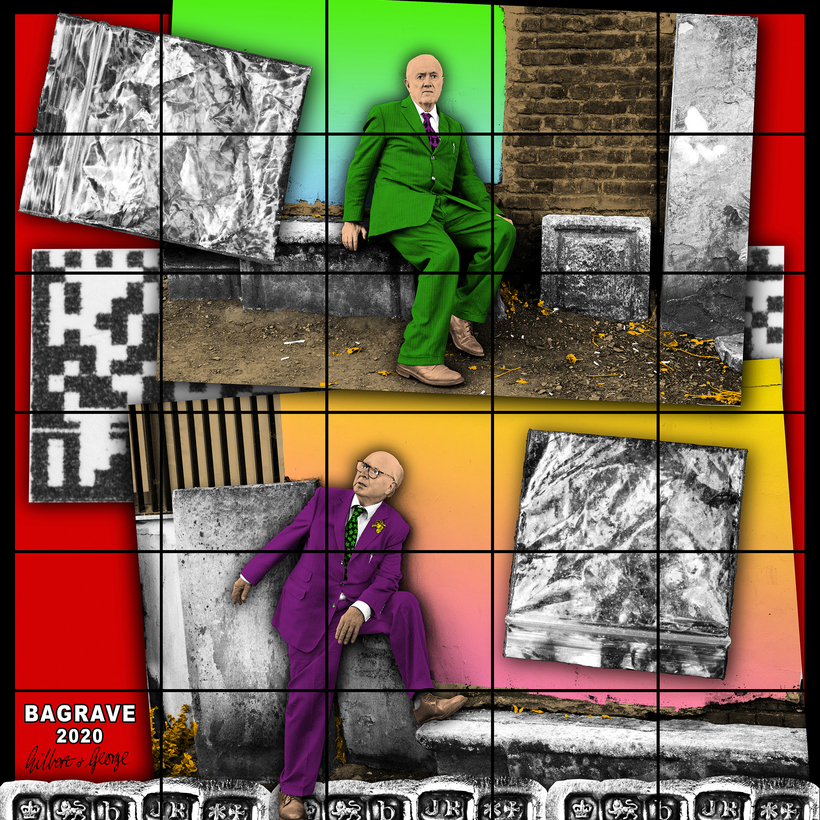“They present as conservative, but their pictures are fearless and radical,” says Tom Hunt, a director at Galerie Thaddaeus Ropac in London. He’s talking about that singular artistic marriage of two men—Gilbert Prousch and George Passmore—companions in life and art, who met at Saint Martin’s School of Art and united under the signature Gilbert & George when they began exhibiting as “living sculptures,” in 1968. They never looked back.
Over the last 18 months, the British duo has created approximately 85 New Normal Pictures, a series whose title refers to the pandemic’s life-changing lockdowns. Twenty-six showed at London’s White Cube in April and May; through July 31, Thaddaeus Ropac’s Paris Pantin gallery presents a different 19 from the series.

“It’s exciting because it’s like having Londoners arriving at a time when no one’s been allowed to go anywhere,” says Hunt. “If anyone represents the essence of London artistically, it’s Gilbert & George, similar to how Dickens was the quintessential Londoner.”
Indeed, Gilbert & George describe Fournier Street—their home of more than 50 years in Spitalfields, East London—as “the world.” George reiterated this when I met the two of them at White Cube in April: “It’s a French street, built on a Roman cemetery. Spitalfields was home to returning crusaders; till 1900 there was a Russian vapor bath here, and Oscar Wilde came to Brick Lane for opium. We had a mosque and synagogue on our street. It’s a marvelous example of what it is to live safe and free, because of culture. Europe, America, and Australia are safe and free. Most other territories are not—they’re in the grip of dictators or the church. So many people suffered and strived to get us to this amazingly privileged position, and we want to be grateful for that and add to the culture. Fournier Street is an extraordinary part of the real world—past, present, and future—and all the New Normal Pictures are part of the past, present, and future. We’ve never made a picture without those three elements.”
Visitors to Paris Pantin will see wall-size works that feature Gilbert & George—dressed in their trademark suits—tilting against railings, sprawling in graffiti-plastered bus shelters, wandering among deflated balloons and discarded champagne foils, slouching on park benches, standing alongside gold and silver figures, and gazing at violently blazing skies. The pictures are gloriously brutal, depicting London’s squalor and beauty in lurid Day-Glo hues. “The colors come from expressing our inside,” says Gilbert. George adds, “The colors are not there for people to enjoy but to carry the message, feelings, and themes to the viewer. Every single picture is a visual love letter from us to the viewer.”

The pictures are instantly recognizable for their black grids. Gilbert explains that this system allows them to dismantle pictures that are “as big as a house” and move them quickly and easily around the world. “We can’t compose the pictures entirely as we want because of the grids, so it’s a discipline that we quite like,” says George, “and people realize it’s our picture even from a mile away without seeing the subject.” Gilbert adds, “Even on a matchbox, people say, ‘Aah! That’s a G&G—what are they telling us today?’”
Hunt doesn’t disagree. “Their pictures are as recognizable today as they were in 1971. As they depict their city changing around them, Gilbert & George are consistent—virtuoso, bona fide two-offs.” —Charlotte Metcalf


 Discover
Discover